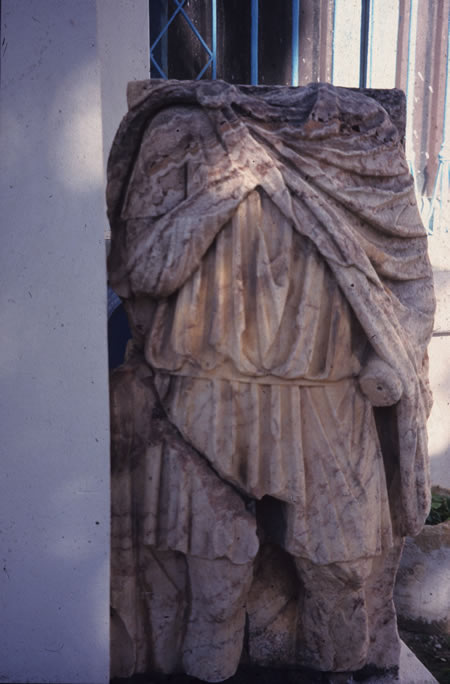FORUM BASILICA’S PORTICO

A series of entablature fragments, which were hewn from a striated stone that varies from a purplish-red to a creamy white, are located throughout the forum area at Meninx. The origin of this stone remains unclear. Luciano Mulazzani, an Italian geologist who specializes in Tunisian stones, believes that this stone comes from one of the quarries at Jebel Oust, near Thuburbo Maius. The length of these blocks demonstrates that the Punic cubit was used for these blocks. Several of these striated blocks have a length of c. 1.28-.29 m, which equates to 2 1/2 PC and 4 3/8 RF. The use of the Punic cubit as the unit of measure suggests that this quarried from a site that once was under the control of the Carthaginian Empire.
Located throughout the forum area are a series of fragments that were one time part of the sculpted pillars that probably decorated the forum basilica’s portico. The fragments can be divided into two groups: one, pillar fragments with sculpted figures on them, and two, parts of the pillars. Six sculpted figures, five figures in eastern dress and one winged Victory, were found in the storage of the Bardo Museum. One is in the Louvre, and a mutilated sculpted figure was recovered on site. These figures were to be seen frontally; the backs of the figures rest against the pillar. The backs of some (but not all) of the pillars were carved to look like pilasters. The tops of the pillars are also preserved.
The fact that only some of the sculpted pillars have pilasters and that those that do only some have reeding has interesting implications and several interpretations. One, since the backs of the sculpted pillars are so diverse, one could argue that the these stones are re-used, just like the cornice blocks that are re-used as foundation blocks for the basilica’s columns. In this interpretation only the front would be important. Two, since the backs are different, it is possible that the sculpted pillars were displayed in such a manner that only some had their reverse visible. This would explain why some had the reverse carved and some did not. This does not explain why some had reeding and others did not. Adding to the complexity of this issue is that the sculpted pillars are not carved from the same type of stone.
